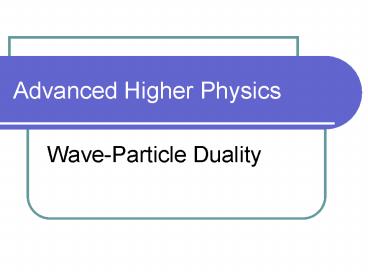Advanced Higher Physics PowerPoint PPT Presentation
1 / 13
Title: Advanced Higher Physics
1
Advanced Higher Physics
- Wave-Particle Duality
2
History
- Unexplained phenomena observed in early 20th
century - Did not fit with classical wave or particle
models for previous situations - Lead to new physical theory Quantum Physics
3
Photo-electric Effect 1
- photo-current flows in circuit when cathode is
illuminated with e-m radiation of sufficiently
high frequency, f - Potentiometer used to provide stopping
potential, reducing photo-current to zero - Stopping potential relates to kinetic energy of
photo-electrons emitted from surface of cathode
4
Photo-electric Effect 2
- stopping potential (i.e. kinetic energy of
photo electrons) found to be independent of
intensity of radiation - KE of photon electrons dependent on frequency of
radiation - below threshold frequency, f0, no photo
electrons are emitted
5
Photo-electric Effect 3
- Observations explained by Einsteins quantum
theory of light - Light travels as photons or wave packets
- Photon energy, E hf or E hc / ?
- where h Plancks constant
- f frequency
- c speed of light
- ? - wavelength
6
Photo-electric Effect 4
- Kinetic energy of photo electrons given by
- KE h(f f0)
- where h Plancks constant
- f frequency of incident radiation
- f0 threshold frequency for cathode
7
Compton Scattering 1
- 1920s experiments by Arthur Compton
- X-rays used on thin graphite sheets
- Some x-rays found to be scattered
- Scattered x-rays found to have longer wavelength
- Explained in terms
- of collisions between
- photons and electrons
8
Compton Scattering 2
- Incident x-rays have frequency, f, and energy, E
hf - Scattered x-rays have frequency, f', and energy,
E hf' - Kinetic energy of electron after collison,
recoil energy, KErecoil hf - hf' - f' lt f , so wavelength of scattered x-rays, ? gt
?
9
Compton Scattering 3
- Compton looked at linear momentum
- Combining Einsteins relativistic energy, E mc2
and photon energy, E hc / ? - We get photon momentum, p h / ?
10
Compton Scattering 4
- Using conservation of energy and (relativistic
momentum) Compton showed that - So, ?? is dependent on scattering angle, ?.
- This cannot be explained by the wave model of
light, only the particle model.
11
De Broglie Wavelength 1
- De Broglie applied photon momentum equation, p
h / ?, to particles - Suggested that particles with momentum, p, could
have wavelength, ?, given by, ? h / p - Effect later observed using electron beams
- De Broglie wavelength exists for all moving
bodies (normally undetectable)
12
De Broglie Wavelength 2
- De Broglie wavelength is basis for
- Electron diffraction to examine crystal and
molecular structures - (including DNA)
- Electron microscopy (? 10-10 m, gives better
resolution than light, ? 10-7 m)
13
(No Transcript)

